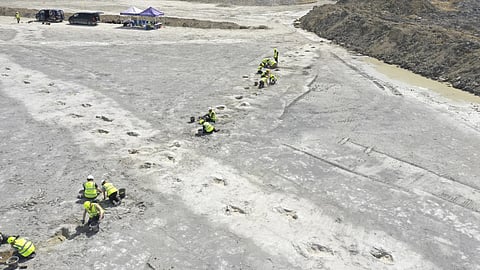

A team of researchers in Oxfordshire, United Kingdom, has uncovered one of the world's longest sequences of dinosaur footprints, revealing a 220-metre trace left behind by a massive sauropod that lived on the Earth 166 million years ago.
The discovery was made at Dewars Farm Quarry in Oxfordshire, where scientists from all around the UK, including Oxford University's Museum of Natural History, collaborated to reveal the prints.
The trackway was discovered buried beneath tonnes of rock after a controlled explosion removed layers of ancient limestone.
Emma Nicholls of Oxford University's Museum of Natural History described the discovery as astonishing, adding the footprints were "insanely big."
Palaeontologist Kirsty Edgar from the University of Birmingham told the BBC, “We’re uncovering something that people have never seen before. It’s so rare to find something this big.”
The largest trackway, commonly known as the dinosaur superhighway, spans the quarry and is thought to have been left by a sauropod akin to Cetiosaurus.
This long-necked, four-legged dinosaur could reach 18 metres in length. Each footprint is around one metre wide, or roughly twice the size of an elephant's foot.
Along with the gigantic sauropod tracks, smaller three-toed footprints possibly belonging to Megalosaurus, a two-legged predator up to nine meters long, were discovered.
Scientists discovered that the sauropod walked at roughly two metres per second, which is comparable to a fast human walk. One footprint seemed slightly out of place, implying that the dinosaur had stopped in its tracks or slipped briefly.
This discovery could provide information on dinosaur behaviour, movement, and habitats during the Middle Jurassic period, scientists say. The tracks may indicate whether the animals went alone, in herds, or were being hunted.
Palaeontologists have been intrigued by the Oxfordshire quarry for a long time. In recent years, quarry workers discovered hundreds of clawed imprints and submerged traces from herbivores and carnivores.
Researchers from Oxford and Birmingham universities paid a visit in 2023 and discovered three-toed prints of Megalosaurus as well as massive impressions of sauropod feet.
Since 1997, scientists have unearthed more than 40 sets of tracks along 200 yards of pathways, earning the place the nickname "dinosaur highway." While work continues, the Oxfordshire quarry remains one of Britain's most impressive windows into its Jurassic past.
